Observations on Pollen Subs: Part 4- Nectar, Water, and Humidity
Observations on Pollen Subs: Part 4
Nectar, Water, and Humidity
First published in ABJ January 2022
Randy Oliver
ScientificBeekeeping.com
Last month I pointed out that there is something about even a light natural pollen flow that seems to increase a colony’s response to fed pollen sub. But a light pollen flow is often also accompanied by a light nectar flow — perhaps not enough to be noticeable by the beekeeper, but enough to affect the humidity within the broodnest. Could it be that the moisture from a nectar flow (independent of pollen) allows colonies to better utilize artificial diets?
In this series I’m still trying to figure out why I couldn’t get my test colonies to grow, despite non-stop feeding of pollen sub, often along with sugar syrup.
Doug Somerville, in his manual on bee nutrition, [[1]] observes that:
The loss of the stimulating impact of nectar will also equate to a reduction in the area of brood being cared for by the colony. The provision of nectar continues to keep the brood area “open” and population replacement at a high or expanding level. This stimulus can be artificially created by the provision of sugar syrup.
My test colonies all put on plenty of weight from the fed syrup, so they certainly weren’t lacking for sugar stimulation (the continually-fed patties were also half sugar). So could it be the water in nectar that is stimulating?
HUMIDITY & WATER
It was not only unusually hot during the experiment, but also drier (lower humidity) than “normal” (whatever that is nowadays). During the trial I assumed that we had provided the colonies with enough 1:1 sugar syrup to maintain broodnest humidity. But could difficulties in maintaining water homeostasis have been the reason that the relatively-small colonies didn’t expand their broodnests?
Water requirements of colonies
During conditions of hot weather, colonies require water for at least five reasons:
- To replace the water lost from the bees’ bodies during respiration.
- To dilute stored honey so that the bees can use it as an energy source.
- To perform evaporative cooling to prevent overheating of the hive.
- To maintain humidity in the broodnest to prevent desiccation of the eggs and young larvae.
- To allow nurse bees to produce the water-rich jelly (>70% moisture) necessary to feed the larvae
Inside the hive, broodnest humidities are typically held (based upon a scan of the sparse literature on this subject) between 40 and 70% RH, which is not surprising, since ripened honey comes into equilibrium with air at a relative humidity (RH) in the 50-60% range. At higher humidities, honey will absorb water and possibly ferment, at lower humidities water will slowly evaporate from the honey. Those combs of honey, however, appear to exhibit little actual buffering of the humidity between them, indicating that the bees actively regulate the humidity within the cluster [[2], [3]], likely primarily for the benefit of the desiccation-susceptible eggs and larvae. As far as the adult bees, Abou-Shaara [[4]] found that high temperatures coupled with low humidity reduce their longevity, so it’s not surprising that a colony would maintain a “comfortable” humidity in its home.
Experimentally, Harbo [[5]] found that the water requirement of clusters of around 1500 caged bees, kept at a constant 55% RH, increased tremendously as the temperature increased from 77-104°F, while their need for sugar plummeted.
Practical application: Harbo’s finding certainly indicates that worker bees require a lot more water at higher temperatures, but I’m surprised by his finding that sugar consumption decreased, since several studies have found that the resting metabolism of honey bees increases with high temperature [[6]].
It has been often noticed that colonies will desperately forage for water in winter if they are rearing brood [[7]]; this despite the fact that in cold weather they produce an excess of metabolic water in the process of burning honey for energy. Now couple that requirement for water with the need to cool and humidify the broodnest under hot/dry conditions. If there is a nectar flow on, the colony may obtain enough water from that source. But in many arid areas (such as my location in California), not only is there no rain during summer, but no appreciable nectar flow late in the season.
WATER FORAGING AND THERMAL STRESS
How bees forage for water, and use it to adapt to thermal stress, is a fascinating subject, which I’m only going to cover briefly. The short version is that colonies can get desperate for water, due to inability to forage, or to heat waves. When they do get thirsty, mid-age house bees start to beg “water collector” foragers for water. The water collectors then respond by rushing out and bringing water back to the hive [[8]]. Once in the hive, that water gets trophallactically passed between bees, and deposited inside cells surrounding the brood nest, as well as on the top bars of Langstroth hives [[9], [10]] (Figure 1).
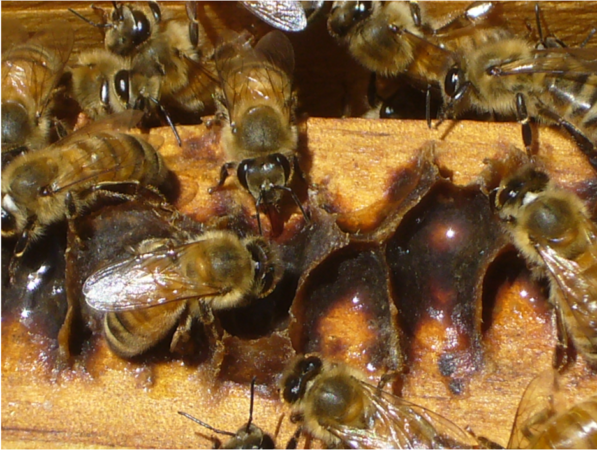
Fig. 1 A photo of the top bars in one of my hives on a hot day. It’s easy to see the glistening water in the burr comb, and to shake water, or very diluted nectar, out of combs.
A landmark study on how a colony uses water was published in 1955 by Martin Lindauer in, [[11]] who concluded that:
The activities necessary to regulate the temperature on overheating are carried out according to the principle of division of labour. There are separate groups of bees for carrying water, for receiving and distributing it in the hive, for spreading it, for working it with their tongues, and for fanning. The individual groups work in harmony together; a direct relationship between overheating and the activity of the water carriers has been established.
Lindauer observed that water foraging increased when a colony was rearing brood, and also found that the same bees that foraged for water for brood rearing were those that brought back water for cooling the hive.
Then in 1997 Susanne Kühnholz and Dr. Tom Seeley followed up with a study [[12]] on how a colony delegates the task of water reception (from the water foragers) to mid-age bees, and confirmed Lindauer’s suggestion they were the ones who controlled the amount of water foraging by how eagerly they beg for or refuse water offered by returning foragers. The water receivers then transport the water inside the hive, sharing it with mid-aged workers or smearing it on the walls of cells.
Allow me to quote from the paper:
Apparently, a colony adjusts the number of water receivers by means of bees switching to water reception from both nectar reception and other tasks, in accordance with the colony’s water need … The results of this experiment show that when we heated the observation hive, the colony strongly increased its water collection but did not decrease its nectar collection. These results also show that our focal nectar collector did not experience greater difficulty in unloading a concentrated sugar solution when the colony boosted its intake of water, and as a result was not at all discouraged from collecting a rich sugar solution throughout the period of severe heat stress.This supports the idea that a colony can raise its water collection without simultaneously lowering its nectar collection. [Boldface mine]
As the colony’s need for water increased, the bees that had previously worked as water collectors were increasingly begged for fluid by their nestmates. This result suggests that being begged more often stimulates the inactive water collectors to resume their water collection work.
Dr. Seeley followed up on this research with Madeleine Ostwald and Michael Smith in 2016 [[13]], confirming that hive bees stored water not only in their crops, but also in the combs near where water collectors returned from their flights.
Curious about how the Arabian bee deals with water, I corresponded with Dr. Abdulaziz Alqarni, who mentioned three observations by beekeepers in Saudi Arabia:
- The native honey bee (m. jemenitica), collects water during hot noon times while European bees don’t.
- Jemenitica place more water drops on top of the frames than do Europeans.
- They also place small water droplets in the area between the brood cells.
Surprisingly, Abou-Shaara [[14]] found that his colonies in Saudi Arabia ignored a dish of water with floats placed next to the combs.
COLONY REQUIREMENT AND DISTRIBUTION OF WATER
Standifer [[15]] found that in Arizona, where they controlled the water source for an apiary, that after accounting for evaporation, that weekly average consumption of water by a colony was in the 5-9 liter range (roughly a liter a day), whereas during winter it was around a liter a week.
Practical question: The above observations made me curious as to whether I might encourage brood rearing during hot, dry weather by offering colonies water inside the hive.
So I ran a small experiment with three colonies, placing an empty box on top, and offering the bees a choice between heavy syrup (77% sugar) or fresh water, during a July heat wave, in which daily highs reached 105°F (Figures 2 & 3).
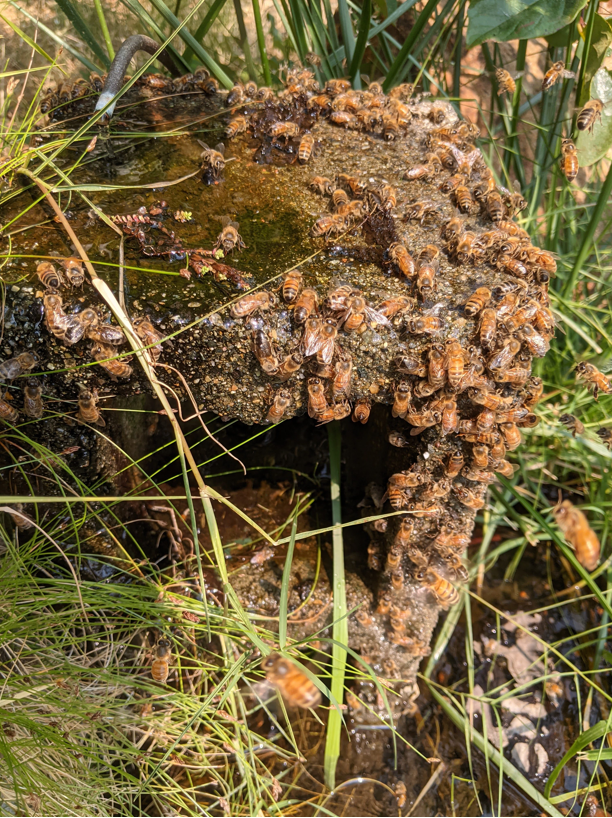
Fig. 2 There were plenty of foragers eagerly collecting water during the experiment. I have a few dedicated bee water sources at my home yard (this one with water dripping onto a cinder block). On hot days there are freeways of water foragers between the hives and the water sources.
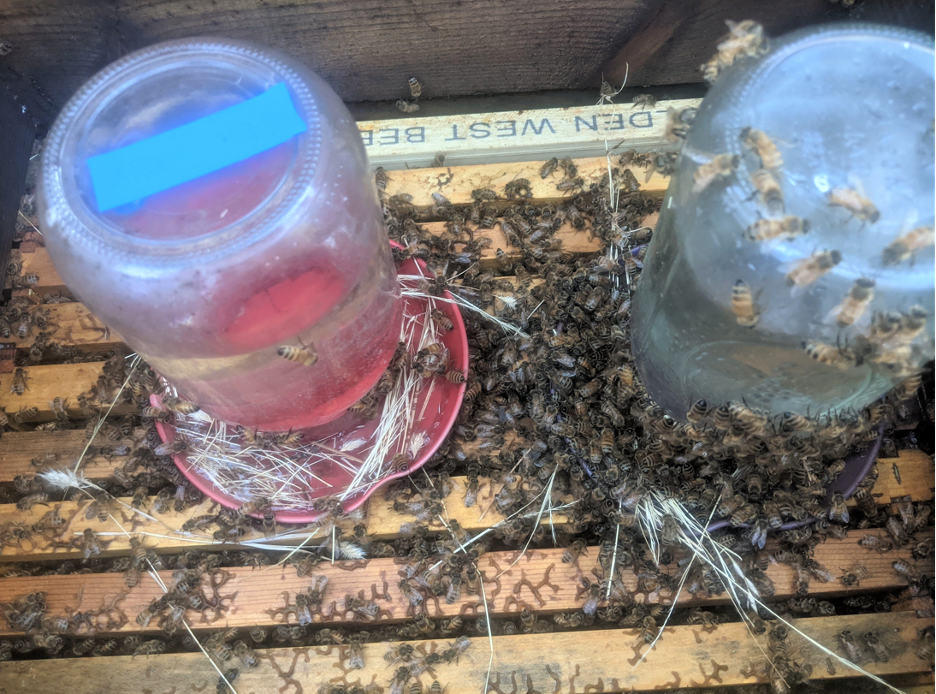
Fig. 3 In this experiment I gave the bees a choice between plain water (left) and 77% sugar solution (right), placed on the top bars (surrounded by an empty hive body and cover). I refilled the jars in the morning (so the bees would be already trained to their location, and took this photo in late morning as the colonies started fanning loudly at the entrances as they desperately tried to cool their hives. By that time there was a column of water foragers beelining to a nearby pond.
Similar to Kühnholz’s observations (and to my great surprise), despite the heat and dryness, the bees took the heavy syrup more rapidly than water every time. However, they did eventually take the water too, although there was never a ring of bees around the trough with their proboscises in the water. They consumed an average of 2/3 quart of water a day (after accounting for evaporation from the trough) — similar to the amount consumed in Arizona.
Practical question: The lack of interest is such a readily-available water source (similar to Abou-Shaara’s observations) made me wonder whether I was missing something — did the colony treat water offered in a feeder differently than water brought back by water collectors? How could I tell where they placed the syrup or water taken being fed at the top of the hive?
So I ran a second experiment, offering a single-deep colony, again in hot, dry weather, with two dishes each of two choices of liquid — one heavy syrup (tinted with red food coloring), the other plain water (tinted blue). Then I waited a few hours (at which point all liquid had been taken) and pulled each and every frame to see whether and where the bees had placed either liquid. I used dozens of Q-tips to look for colored liquid by inserting them into cells throughout each comb (Figure 4).
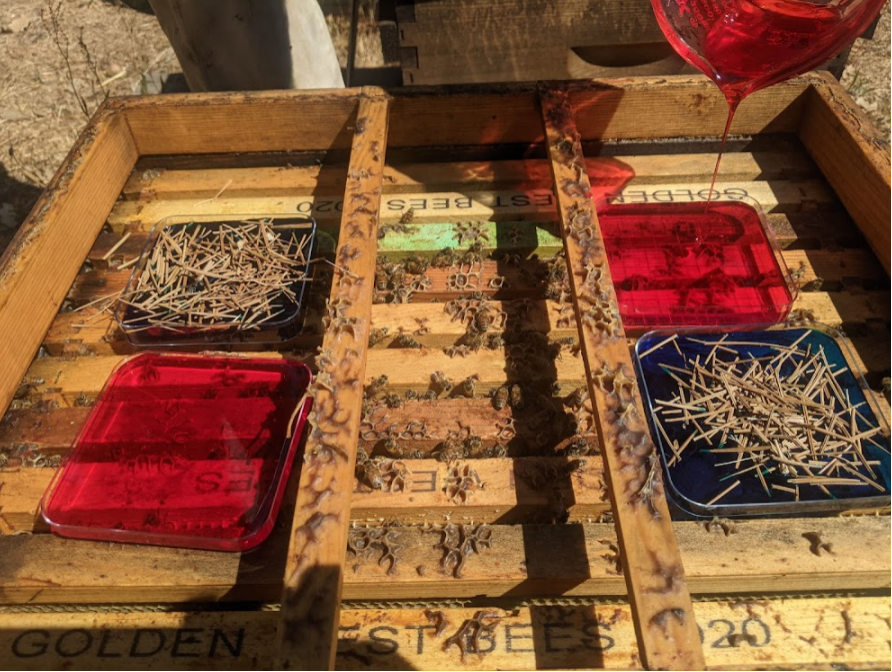
Fig. 4 In this photo I’m pouring the red-tinted heavy syrup into a dish. I would then sprinkle pieces of pine needles, as shown in the dishes of blue-tinted plain water, to prevent drowning. I then replaced the hive cover over the 1.5” rim, and let the bees suck the trays dry.
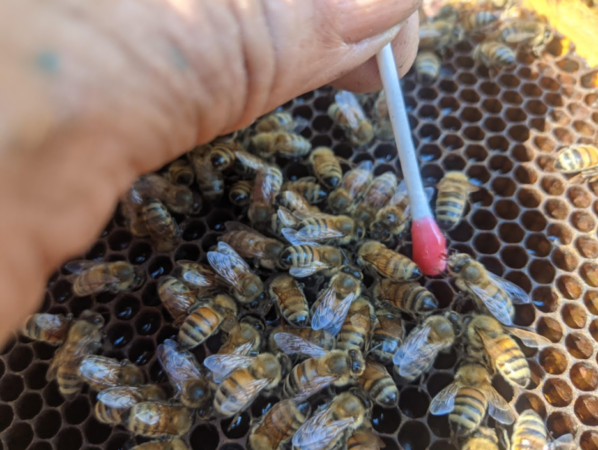
Fig. 5 The above is typical of how a Q-tip looked as I withdrew it from a cell containing stored red-tinted syrup. The method clearly differentiated between red syrup and blue water, and worked very well for a quick assessment of the distribution of either liquid in the hive. Very few Q-tips showed blue water, likely because the water had already evaporated or been consumed.
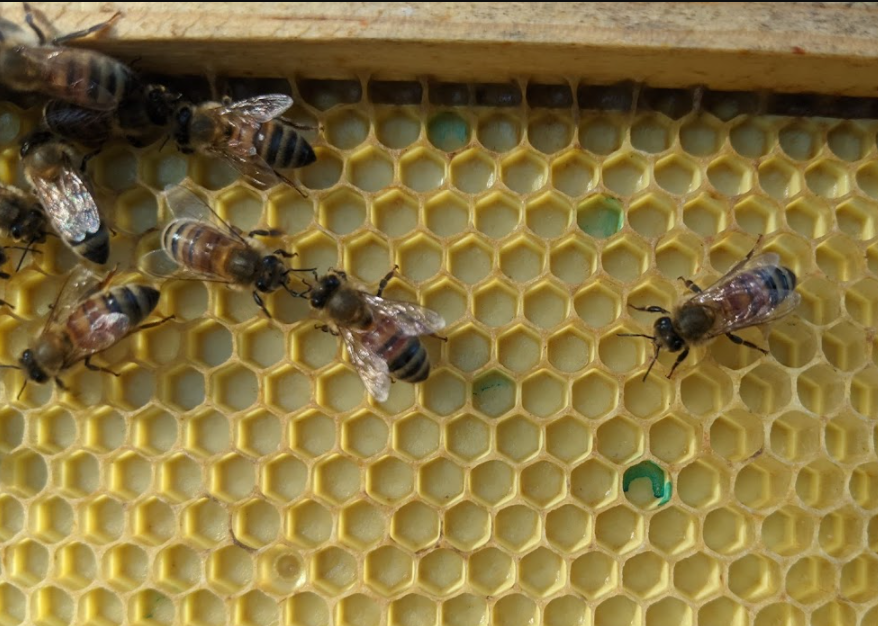
Fig. 6 In this outer frame of partially-drawn foundation I detected only blue color, with the water already evaporated. Not shown is that there were also blue stains along the bottom and upper surfaces of the top bars all across the hive.
Findings and practical application: I found blue color (indicating water) scattered only in the outermost frames and near the top bars — all in the periphery of the cluster. I found red syrup (indicating syrup) in far greater amount, but only within (and widely throughout) the broodnest and in the open cells of uncured honey within the cluster. It appeared that the bees that took the water drank some, and used the rest for evaporative cooling at the edge of the cluster. Bottom line: Yes, a colony appears to utilize water offered within the hive similar to how it uses water brought back by foragers.
In this experiment, I didn’t find any evidence of plain water being placed in the brood area, but that may be because it dried without being stored — Stabentheiner [[16]] shows a thermal photo of how bees cool the broodnest by evaporating droplets of water, which may cover up to 7% of the brood area [[17]]. On the other hand, there was plenty of heavy syrup stored around the brood, but at 77% sugar, one wouldn’t expect there to be much evaporation of moisture.
So I decided to return to my original question.
BACK TO MY ORIGINAL QUESTION
Practical question: Could the reason that my test colonies late last summer failed to expand their broodnests have been due to the colonies’ inability to maintain broodnest humidity during the hot, very dry weather?
Eggs and young larvae require high relative humidities to avoid desiccation [[18]]. There’s not a whole lot of published data on how closely colonies regulate broodnest humidity under various conditions. But by good fortune, I was able to obtain broodnest humidity data from two beekeepers who shared recordings from hives of their own with me. Comparing broodnest humidity measurements from colonies from very different temperature and humidity environments might allow us to tease out the minimum and maximum broodnest humidity targets that colonies aim for.
Etienne Tardif recorded data during a cool, humid summer in the Yukon. Under these conditions, a colony can relatively easily regulate its “preferred” minimum relative humidity [[19]] (Figure 7).
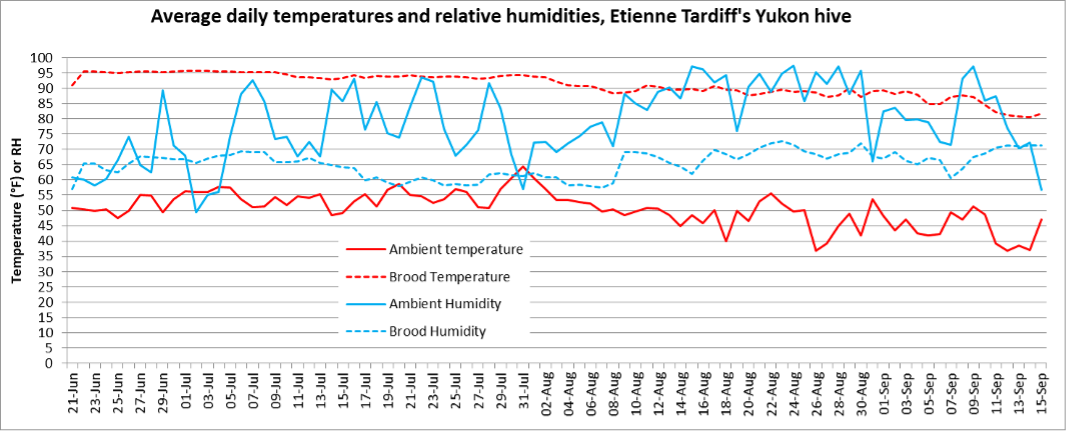 x
x
Fig. 7 Despite cool temperatures (mostly in the 40s to 50s F) and high ambient relative humidities (often above 90%), Etienne’s colony maintained a broodnest RH in the 55 to 70% range (averaging 65% over the course of the summer). The above data suggest that bees “prefer” a minimum broodnest RH of around 60%.
On the other hand, in a warm, humid climate it’s difficult for bees to lower broodnest humidity below ambient humidity, so we can find their maximum “preferred” limit. Russ Litsinger provided data from his hive in Kentucky (Figure 8).
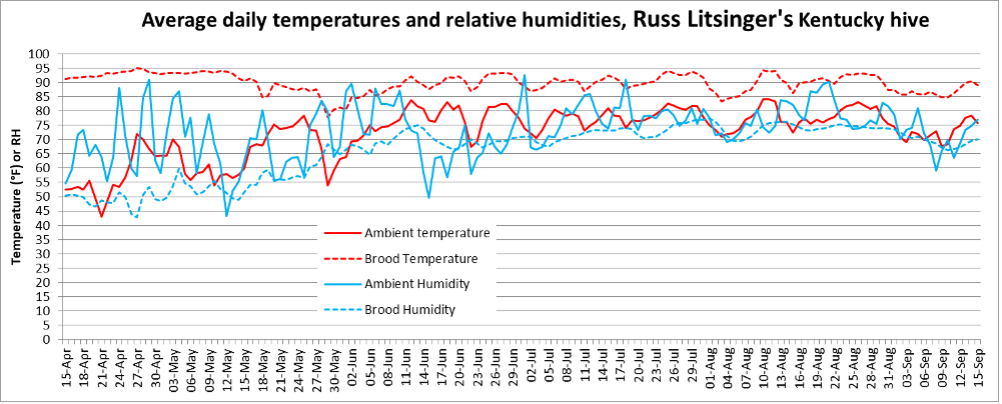
Fig. 8 Although ambient temps and RHs were often in the 80s, Russ’s colony was able to maintain broodnest RH in the same 50-70% range until higher summer temperatures and RH prevented them from being able to drop the internal RH by warming the air around the brood combs, resulting in a summer average RH of 72%. This suggests the upper limit for “preferred” broodnest humidity.
Practical application: The two graphs above confirm what other researchers have found — that despite greatly-varying ambient conditions, colonies attempt to maintain the relative humidity in the broodnest between the 50 and 75% RH setpoints, with the “preferred” range appearing to be 60-70% (perhaps a bit higher near eggs) [[20]].
So could relatively-small colonies in my hot and dry summer environment maintain broodnest RH in the 50-70% range? In order to see, I bought some humidistat/thermometers, and for preliminary testing measured the conditions between frames of colonies of different strengths and configurations.
My preliminary observations suggested that humidities tended to be higher in upper brood chambers than in lower. So for a worst-case scenario, I monitored the RH and temperature (for several days) of a single-deep weak colony in a dark-colored hive, in 100°F weather with no noticeable nectar flow. The RH next to their brood ranged from 60-80%, indicating that even a weak colony being blasted by the sun was able to maintain broodnest humidity under hot, dry conditions.
Surprised, I wanted some more detailed information. So I then set up a colony in the same configuration as the colonies in the trial last October (double deep, honey in the upper chamber, seven frames covered with bees, three frames in the lower chamber containing brood). I placed eight sensors, one outside the hive, the rest between frames in the lower chamber — three between the brood frames, the rest between honey frames, and recorded their readings hourly over the course of three warm days in October (Fig. 9).
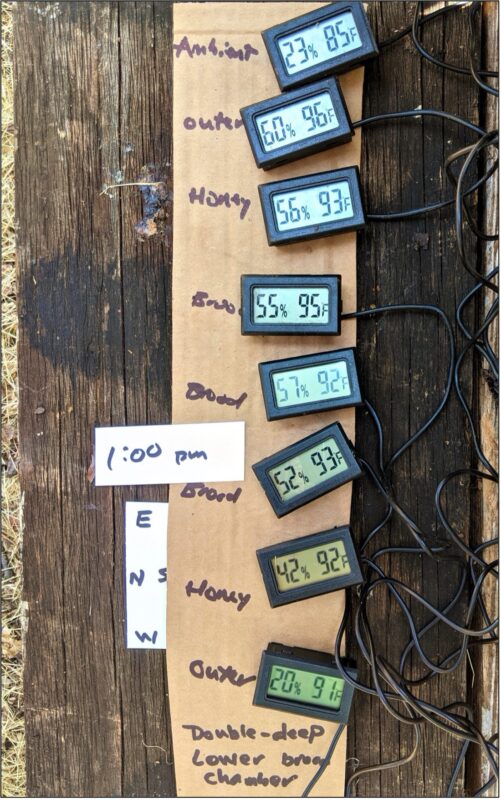
Fig. 9 Cheapskate that I am, rather than using data loggers, I crudely took photos of the readings every hour. There was a very light nectar flow on, and the full sun hit the hive around 11:00 each morning, then light shade occurred again around 2:00 pm.
Etienne and Russ provided me with daily averages data, which may be best for indicating target humidities, since a study by Hannelie Human [[21]] indicated that broodnest humidities may increase during the night. What I was really interested in was how low my colony would allow broodnest humidity to drop hour-by-hour during daytime. So I recorded hourly readings over the course of three days, with nighttimes indicated by gray columns (Fig. 10).
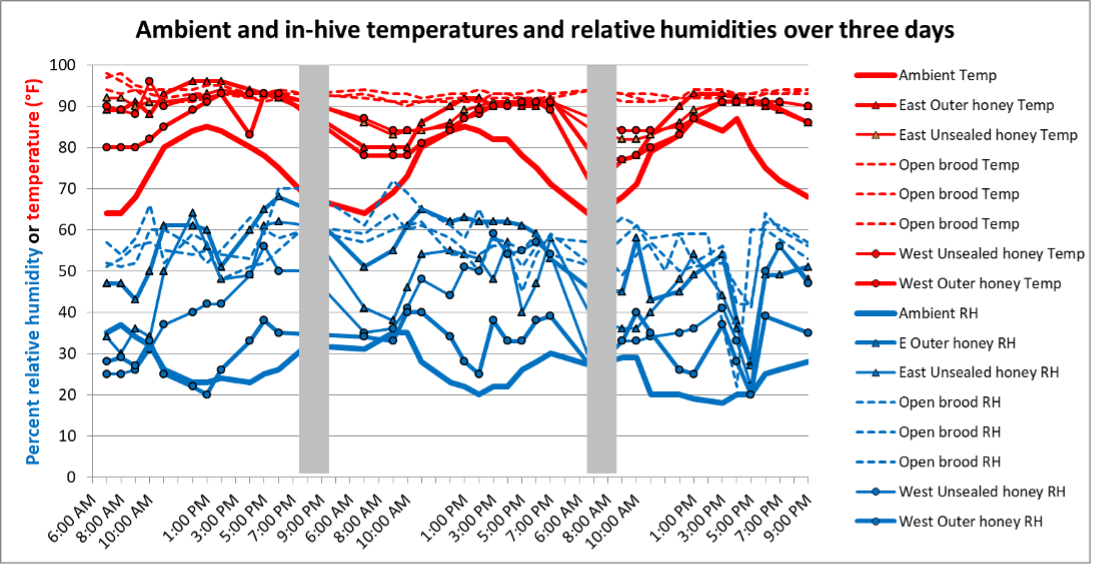
Fig. 10 First note that ambient temperature and humidity (heavy solid lines) were inversely proportional — as the air warmed, relative humidity decreased. Not so within the cluster. The colony easily maintained the brood at a near-constant temperature (red dashed lines), and certainly appeared to be able to maintain humidity between the brood frames (blue dashed lines) in the “normal” 50-70% RH range (overall daytime broodnest RH averaged 57%). At nearly all times during these three days, temperature and humidities between the frames were higher and more moderated than those outside the hive.
The only odd observation was that the RH next to unsealed honey (thin solid blue lines) was always higher on the east side of the hive (triangle markers). This may be where they tended to store and evaporate incoming nectar or water.
Another beautiful hypothesis slain — it appears that during hot, dry weather even weak colonies are able to maintain broodnest humidity in the 50-70% range. But that doesn’t mean that such maintenance doesn’t come at a cost — Yildiz [[22]] found that it takes a lot more energy for bees to cool their hive than to heat it.
Practical application: So I can’t blame the weather or lack of moisture for the lack of growth of these continually-fed colonies. I thus wrap this series up with what I mentioned in my last installment — that I suspect that the stimulation for brood rearing, is not just about placing protein patties somewhere in the hive, but is rather about providing the right cue(s) to the nurse bees to cease “brood trimming” and instead rear every laid egg to maturity, thus resulting in colony growth. Those cues likely have something to do with the placement of incoming nectar or pollen directly into the center of the broodnest, which thus informs the nurses that a flow is on, and it’s time for the colony to grow. We clearly need to learn more about the best placement of pollen sub within the hive.
UPDATES:
A very interesting article came to my attention after writing the above. It was written by Henry Pirker, a beekeeper in Alberta, Canada, who paid close attention to his indoor-wintered colonies. He observed that colony behavior when in winter cluster was all about humidity. Even when supplementally fed light sugar syrup to provide moisture, when colonies would sporadically “warm up” their brood area, and the queen would fill it with eggs, the nurse bees then consume those eggs rather than produce jelly to feed larvae.
Pirker experimented with raising the humidity in his storage room, and found that doing so would result in a number of observable colony behaviors, as well as the humidified colonies immediately engaging in rearing large amounts of brood.
Pirker concluded that: Perhaps in trying to understand the nature of our bees, we should be reminded that they evolved in the lands around the Mediterranean Sea. Drought periods posed at least as great a challenge as the cool seasons. It is not merely a coincidence of nature that the defensive mechanism of Apis mellifera functions equally against drought and cold. Must not, indeed, our winter with its minute available humidity appear to the bees primarily as a prolonged, severe drought season?
Pirker, H (1978) Steering factor humidity. ABJ Dec 1978: 786-789.
Perhaps I was too hasty in letting lack of moisture off the hook. “Moisture” is not just about humidity – it’s also about the amount of water required for the nurse bees to produce jelly.
In his excellent book “Fat Bees, Skinny Bees”, Doug Somerville notes:
.Ample available nectar in the field also acts as a stimulus to the colony, encouraging increasing interest by the colony for pollen and an expansion of the areas of brood within the colony.
Following upon this, I ran a rough calculation as to how much incoming water a colony actually needed (from either nectar or water foragers) to produce the high-moisture jelly necessary for rearing larvae.

ACKNOWLEDGEMENTS
Thanks to Etienne Tardif and Russ Litsinger for data and discussion, Dr. Alqarni for his observations, and to Peter Borst for library assistance.
REFERENCES
[1] Somerville, Doug (2005) Fat Bees Skinny Bees, A manual on honey bee nutrition for beekeepers. Rural Industries Research and Development Corporation, Australia.
[2] Ellis, M, et al. (2008 Hygropreference and brood care in the honeybee (Apis mellifera). Journal of Insect Physiology 54(12):1516-21.
[3] Li Z, et al. (2016) Drone and worker brood microclimates are regulated differentially in honey bees, Apis mellifera. PLoS ONE 11(2): e0148740.
[4] Abou-Shaara, H, et al. (2012) Tolerance of two honey bee races to various temperature and relative humidity gradients. Environmental and Experimental Biology10: 133–138.
[5] Harbo, J (2000) Heating adult honey bees to remove Varroa Jacobsoni. Journal of Apicultural Research 39(3-4): 181-182.
[6] Kovak, H, et al. (2007) Respiration of resting honeybees. J Insect Physiol. 53(12): 1250–1261.
[7] Chilcott, A, & T. Seeley (2018) Cold-flying foragers: Honey bees in Scotland seek water in winter. ABJ 158(1): 75-77.
[8] Bordier, C, et al. (2017) Colony adaptive response to simulated heat waves and consequences at the individual level in honeybees (Apis mellifera). Sci Rep 7: 3760.
[9] Park O (1923) Water stored by bees. ABH 63: 348-349.
[10] Nicolson, S (2009) Water homeostasis in bees, with the emphasis on sociality. The Journal of Experimental Biology 212: 429-434.
[11] Lindauer, M (1955) The water economy and temperature regulation of the honeybee colony. Bee World 36(6): 105-111.
[12] Kühnholz, S., Seeley, T. (1997) The control of water collection in honey bee colonies. Behav Ecol Sociobiol 41, 407–422.
[13] Ostwald, M, et al. (2016) The behavioral regulation of thirst, water collection and water storage in honey bee colonies. Journal of Experimental Biology 219: 2156-2165.
[14] Abou-Shaara, H (2012) Notes on water collection by honey bees. Bee World 89(4): 86-87.
[15] Standifer, L, et al. (1973) Supplementary feeding of honeybee colonies in Arizona. ABJ 113: 298 -301.
[16] Stabentheiner, A, et al. (2021) Coping with the cold and fighting the heat: thermal homeostasis of a superorganism, the honeybee colony. Journal of Comparative Physiology A, 207(3): 337-351.
[17] Their Figure 7c, and Table S1.
[18] Doull, K (1976). The effects of different humidities on the hatching of the eggs of honeybees. Apidologie 7(1): 61-66.
[19] Download a psychometric chart: (https://www.engineeringtoolbox.com/docs/documents/816/psychrometric_chart_29inHg.pdf
At 50°F at a RH of 90%, a pound of air holds 50 grains of moisture. But if the bees warm that air to broodnest temperature, its RH drops to only 20%. Thus, they would need to add moisture, so Etienne’s data would suggest the lowest broodnest RH limit targeted by bees. Conversely, Russ’s data would suggest the highest broodnest humidity allowed.
[20] Li, Z, et al. (2016) Drone and worker brood microclimates are regulated differentially in honey bees, Apis mellifera. PLoS ONE 11(2): e0148740.
[21] Human, H, et al. (2006) Do honeybees, Apis mellifera scutellata, regulate humidity in their nest? Naturwissenschaften 93: 397–401.
[22] Yildiz, C & M Özilgen (2019). Thermodynamic assessment of the impact of the climate change on the honeybees. International Journal of Global Warming, 17(2): 185-218.



